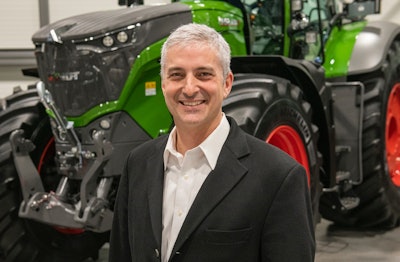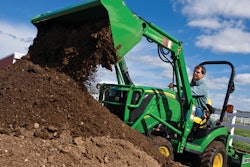
No market segment has escaped the market upheavals caused by the global pandemic. The agricultural equipment marketplace is no exception. It’s been a very challenging year, where supply disruptions, equipment and parts shortages, and overall uncertainty have weighed heavily on all segments.
Eric Hansotia, AGCO Corporation chairman, president and CEO, recently sat down with us for an exclusive one-on-one interview to share his views on how the marketplace is responding, lessons learned, and what lies ahead for the agricultural equipment industry.
Hansotia was named to his current position in January, after serving as senior vice president, chief operating officer. In that role, he oversaw the company’s regional commercial operations as well as its global product management, engineering, manufacturing and supply chain functions. He joined AGCO in 2013, having served in a variety of roles in the agricultural equipment industry for more than two decades.
It has certainly been a challenging time in the agricultural equipment industry. How would you describe the current state of the industry?
To lay out what is happening today, we need to look at where we’ve come from. The last peak industry cycle for North America was 2012-2013, when a lot of buying occurred due in part to high commodity prices. Then commodity prices dropped off and there was a general economic slowdown. From late 2013 to 2019 we had reduced equipment demand, and farmers delayed purchases because of tight economies on the farm.
Our equipment fleet was aging. In fact, the age of the fleet was at the highest levels we’ve recorded since we’ve been tracking those numbers. That meant there was a lot of pent-up demand coming into 2020, and we expected a market recovery. Then COVID-19 hit, and it was a dramatic shock to the system. We had shut down production lines, employees working virtually, and an entire market dealing with a new reality. In April 2020, factories in Europe and South America were shut down. While we were able to stay open because we were deemed a critical industry, we were starved for parts because our suppliers were locked down. It was a scary period with no production from those facilities for four to six weeks. And we had the added challenges of working to ensure our employees were kept safe.
Our teams then worked to learn how to manage through COVID, and we got our factories back running again.
How does the current demand situation differ from other high-demand periods?
What we are seeing now is a surge in demand, driven by world economies coming back online. At the same time, we are dealing with a supply chain that has seen unprecedented disruptions. Right now, we have some of the worst supply chain constraints in memory. And it’s impacting all industries, not just equipment. So that’s the reason we are seeing some of these long lead times.
We are starting to open up early order slots into 2022. That’s a bit longer than we normally would like because it means our farmers are waiting longer than they would like. We are doing everything possible to increase our capacity, increase our supply chain performance, and build through the order backlog we have.
What is the outlook going into 2022?
We are picking up the pace, finding new efficiencies in our manufacturing and supply chain, and finding ways to assist our suppliers. We believe it will get better from here forward, although initially not as clean as before COVID.
However, our mission is to return to normal lead times as soon as we possibly can. And we believe it will probably be early next year when we’re back to something more like normal lead times.
When the market starts seeing longer lead times, buyers get worried that they won't get the order slots they want. That can generate more demand for stock orders, which differs from a retail order that has a customer’s name on it. We watch customer orders very carefully and we build those first. And, so far, we've been doing a good job of building those orders as fast as possible.
What is the current market situation teaching you as the company moves forward?
If I simplify it down, we want to streamline our supplier chain. Today, we have 3,500 suppliers. We’d like to get that down to below 2,000. And we want to form a deeper relationship with them, get them more involved with our upfront design and innovation, and have a more robust relationship with them to handle challenging times like this, as opposed to spreading yourself out over a very wide supply base.
We have to remember the entire supply chain has been set up for efficiency. I think there’s going to be a shift to a supply chain that is more resilient. For example, perhaps we source out of two plants in two different locations instead of one plant. We may duplicate some tooling from time to time, so if one spot is hit with a pandemic, or a freight issue, we are not being starved for parts.
What challenges did you face in leading a worldwide company?
COVID was enormously challenging, and it was an incredible shock to the system. We had factories that were shut down, but the costs were still there. We weren’t sure if it was going to last three weeks or three months. And no one knew how to forecast it.
We were very proactive in getting the leadership team together, having virtual meetings every day, seven days a week, through the first phases of COVID. We discussed what was happening across the globe and what we needed to do to respond. We also conducted weekly video calls with our top 850 leaders from across the globe. We would share with them the results for the week, what we have learned, and what new directions we need to take.
We also had to figure out how to help farmers who suddenly had to work with dealers in a virtual environment. We quickly inspired innovation throughout the whole organization and encouraged trying new things, using some of the tools we already have, adapt to meet current demand, and how to find new solutions. We shared these ideas and recognized employees for these ideas. It was a virtuous cycle that moved rapidly through the company. It was creating a culture of clarity in terms of our goals.
We must be innovative and ensure we are doing two things: keeping your fellow employees safe and keeping farmers farming.









